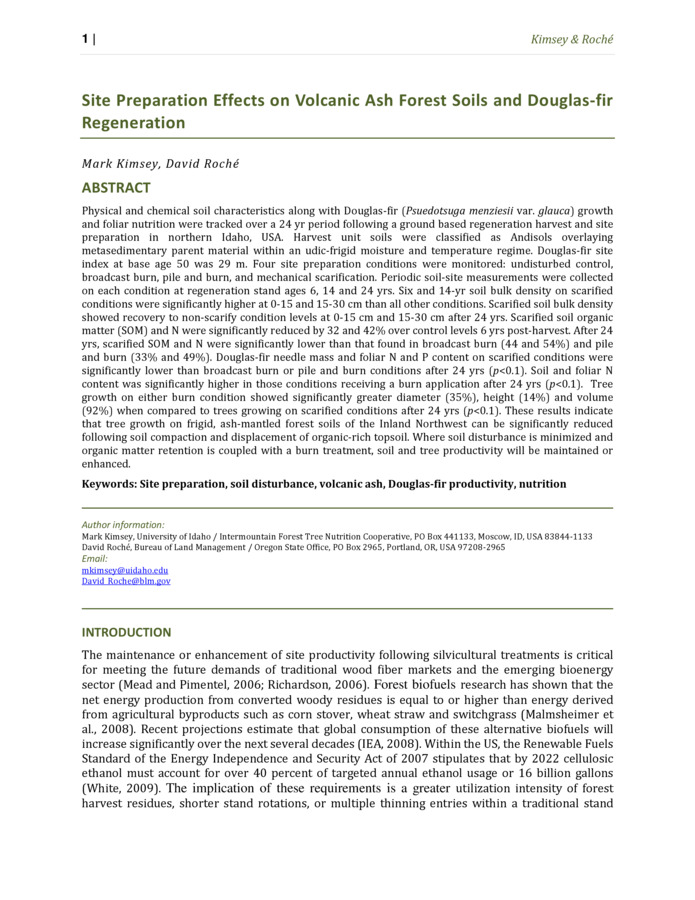PDF
Site Preparation Effects on Volcanic Ash Forest Soils and Douglas-fir Regeneration Item Info
- Title:
- Site Preparation Effects on Volcanic Ash Forest Soils and Douglas-fir Regeneration
- Creator:
- Kimsey, M.; Roche, D.
- Date Created (ISO Standard):
- 2012
- Description:
- Physical and chemical soil characteristics along with Douglas-fir (Psuedotsuga menziesii var. glauca) growth and foliar nutrition were tracked over a 24 yr period following a ground based regeneration harvest and site preparation in northern Idaho, USA. Harvest unit soils were classified as Andisols overlaying metasedimentary parent material within an udic-frigid moisture and temperature regime. Douglas-fir site index at base age 50 was 29 m. Four site preparation conditions were monitored: undisturbed control, broadcast burn, pile and burn, and mechanical scarification. Periodic soil-site measurements were collected on each condition at regeneration stand ages 6, 14 and 24 yrs. Six and 14-yr soil bulk density on scarified conditions were significantly higher at 0-15 and 15-30 cm than all other conditions. Scarified soil bulk density showed recovery to non-scarify condition levels at 0-15 cm and 15-30 cm after 24 yrs. Scarified soil organic matter (SOM) and N were significantly reduced by 32 and 42% over control levels 6 yrs post-harvest. After 24 yrs, scarified SOM and N were significantly lower than that found in broadcast burn (44 and 54%) and pile and burn (33% and 49%). Douglas-fir needle mass and foliar N and P content on scarified conditions were significantly lower than broadcast burn or pile and burn conditions after 24 yrs (p<0.1). Soil and foliar N content was significantly higher in those conditions receiving a burn application after 24 yrs (p<0.1). Tree growth on either burn condition showed significantly greater diameter (35%), height (14%) and volume (92%) when compared to trees growing on scarified conditions after 24 yrs (p<0.1). These results indicate that tree growth on frigid, ash-mantled forest soils of the Inland Northwest can be significantly reduced following soil compaction and displacement of organic-rich topsoil. Where soil disturbance is minimized and organic matter retention is coupled with a burn treatment, soil and tree productivity will be maintained or enhanced.
- Subjects:
- research (document genres) soil science statistics
- Location:
- North and Central Idaho; Eastern Washington; Western Montana; Northeastern Oregon
- Publisher:
- Intermountain Forest Tree Nutrition Cooperative, University of Idaho, College of Forest, Wildlife and Range Sciences, Moscow
- Source:
- Kimsey, M., D. Roche. 2011. Site Preparation Effects on Volcanic Ash Forest Soils and Douglas-fir Regeneration. IFTNC, FRFSci, Univ. of Idaho, Moscow.
- Source Identifier:
- Site_Preparation_Effects_on_Volcanic_Ash_Forest_Soils_and_Dougls-fir_Regeneration_IFTNC_2012
- Type:
- Text
- Format:
- application/pdf
Source
- Preferred Citation:
- "Site Preparation Effects on Volcanic Ash Forest Soils and Douglas-fir Regeneration", Idaho Forestry Research Collection, University of Idaho Library Digital Collections, https://www.lib.uidaho.edu/digital/forestryresearch/items/forestryresearch951.html
Rights
- Rights:
- Educational use includes non-commercial use of text and images in materials for teaching and research purposes. Digital reproduction rights granted by University of Idaho Library. For other uses beyond educational use, please contact University of Idaho Library Special Collections and Archives Department at libspec@uidaho.edu.
- Standardized Rights:
- http://rightsstatements.org/vocab/InC-EDU/1.0/

